spring-boot-2.0.3启动源码篇一 - SpringApplication构造方法
前言
spring-boot-2.0.3应用篇 - shiro集成,实现了spring-boot与shiro的整合,效果大家也看到了,工程确实集成了shiro的认证与授权功能。如果大家能正确搭建起来,并达到了认证和授权的效果,那说明我们会用了,说明我们知其然了;很好,能满足工作中的基本要求了。
但是这样就够了吗?很显然还是不够的,知其然而不知其所以然是一道瓶颈,如果我们能跨过这道瓶颈,后面的路会越来越坦荡。就拿上篇博客来讲,我们仅仅只是在ShiroConfig类中加入了几个bean配置,怎么就让spring-boot集成了shiro,shiro又是如何做到认证和授权的,等等一些列问题,如果我们去细想的话,真的有很多疑点需要我们去探索。
既然我们要去探索,势必就要读源码了。源码确实不好读,在我们工作当中,当我们读同事(或者前同事)写的代码的时候,总有那么一句话:草泥马,这是哪个sb写的,萦绕在我们的心头,甚至有时候会发现,这他么是我自己写的啊,哎,我操!有时候读自己写的代码都头疼,更别说看别人写的了。
说了那么多,我们切入到正题,接下来会有一系列的文章来解析springboot的启动过程,而今天我们只看SpringApplication类的构造方法。
SpringApplication类
入口还是那个熟悉的入口:main函数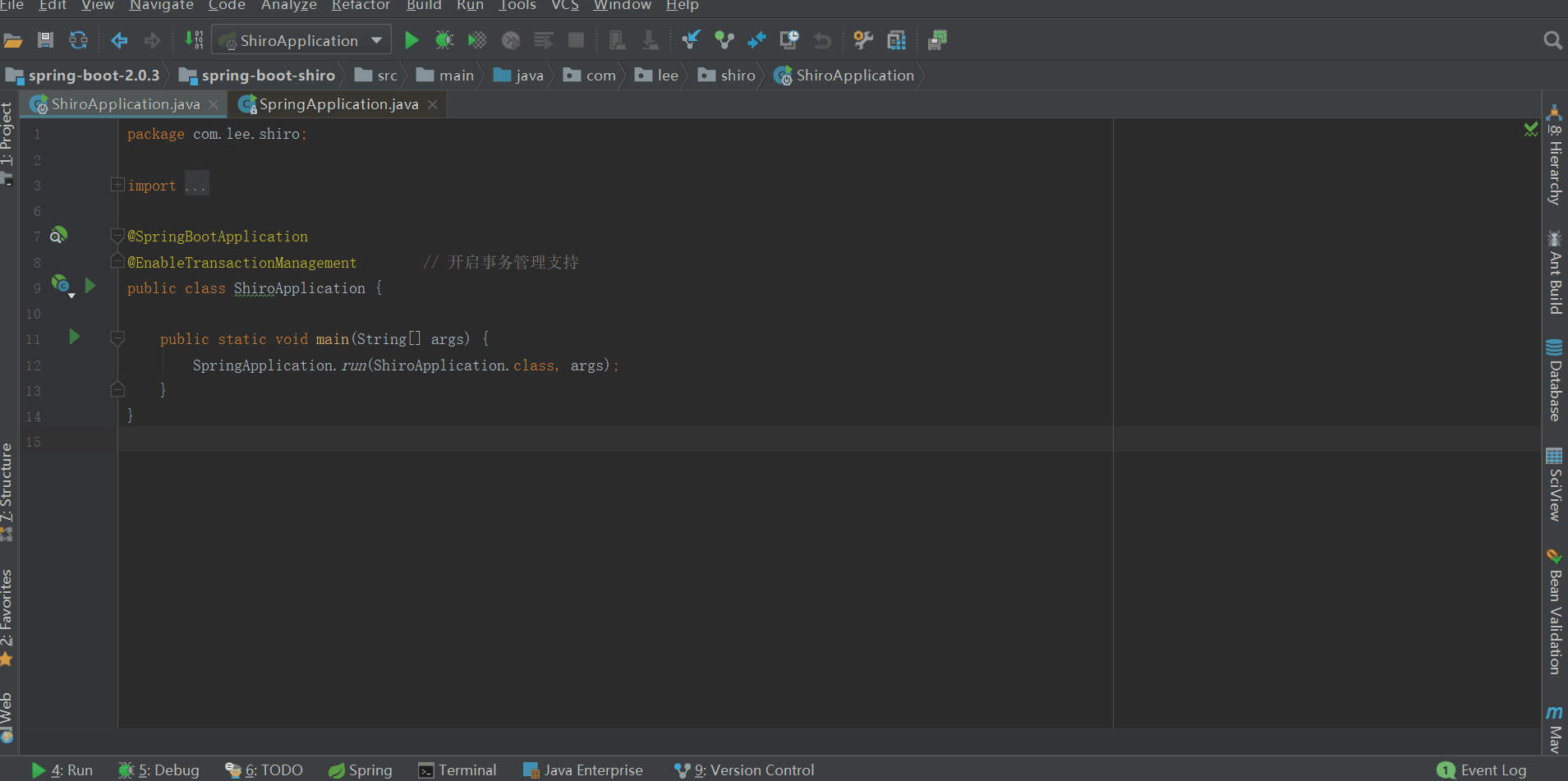
SpringApplication类注释
/**
* Class that can be used to bootstrap and launch a Spring application from a Java main
* method. By default class will perform the following steps to bootstrap your
* application:
*
* <ul>
* <li>Create an appropriate {@link ApplicationContext} instance (depending on your
* classpath)</li>
* <li>Register a {@link CommandLinePropertySource} to expose command line arguments as
* Spring properties</li>
* <li>Refresh the application context, loading all singleton beans</li>
* <li>Trigger any {@link CommandLineRunner} beans</li>
* </ul>
*
* In most circumstances the static {@link #run(Class, String[])} method can be called
* directly from your {@literal main} method to bootstrap your application:
*
* <pre class="code">
* @Configuration
* @EnableAutoConfiguration
* public class MyApplication {
*
* // ... Bean definitions
*
* public static void main(String[] args) throws Exception {
* SpringApplication.run(MyApplication.class, args);
* }
* }
* </pre>
*
* <p>
* For more advanced configuration a {@link SpringApplication} instance can be created and
* customized before being run:
*
* <pre class="code">
* public static void main(String[] args) throws Exception {
* SpringApplication application = new SpringApplication(MyApplication.class);
* // ... customize application settings here
* application.run(args)
* }
* </pre>
*
* {@link SpringApplication}s can read beans from a variety of different sources. It is
* generally recommended that a single {@code @Configuration} class is used to bootstrap
* your application, however, you may also set {@link #getSources() sources} from:
* <ul>
* <li>The fully qualified class name to be loaded by
* {@link AnnotatedBeanDefinitionReader}</li>
* <li>The location of an XML resource to be loaded by {@link XmlBeanDefinitionReader}, or
* a groovy script to be loaded by {@link GroovyBeanDefinitionReader}</li>
* <li>The name of a package to be scanned by {@link ClassPathBeanDefinitionScanner}</li>
* </ul>
*
* Configuration properties are also bound to the {@link SpringApplication}. This makes it
* possible to set {@link SpringApplication} properties dynamically, like additional
* sources ("spring.main.sources" - a CSV list) the flag to indicate a web environment
* ("spring.main.web-application-type=none") or the flag to switch off the banner
* ("spring.main.banner-mode=off").
*/
说的内容大概意思如下:
SpringApplication用于从java main方法引导和启动Spring应用程序,默认情况下,将执行以下步骤来引导我们的应用程序:
1、创建一个恰当的ApplicationContext实例(取决于类路径)
2、注册CommandLinePropertySource,将命令行参数公开为Spring属性
3、刷新应用程序上下文,加载所有单例bean
4、触发全部CommandLineRunner bean
大多数情况下,像SpringApplication.run(ShiroApplication.class, args);这样启动我们的应用,也可以在运行之前创建和自定义SpringApplication实例,具体可以参考注释中示例。
SpringApplication可以从各种不同的源读取bean。 通常建议使用单个@Configuration类来引导,但是我们也可以通过以下方式来设置资源:
1、通过AnnotatedBeanDefinitionReader加载完全限定类名
2、通过XmlBeanDefinitionReader加载XML资源位置,或者是通过GroovyBeanDefinitionReader加载groovy脚本位置
3、通过ClassPathBeanDefinitionScanner扫描包名称
也就是说SpringApplication还是做了不少事的,具体实现后续会慢慢讲来,今天的主角只是SpringApplication构造方法。
SpringApplication构造方法
源代码如下
/**
* Create a new {@link SpringApplication} instance. The application context will load
* beans from the specified primary sources (see {@link SpringApplication class-level}
* documentation for details. The instance can be customized before calling
* {@link #run(String...)}.
* @param resourceLoader the resource loader to use
* @param primarySources the primary bean sources
* @see #run(Class, String[])
* @see #setSources(Set)
*/
@SuppressWarnings({ "unchecked", "rawtypes" })
public SpringApplication(ResourceLoader resourceLoader, Class<?>... primarySources) {
this.resourceLoader = resourceLoader;
Assert.notNull(primarySources, "PrimarySources must not be null");
this.primarySources = new LinkedHashSet<>(Arrays.asList(primarySources));
this.webApplicationType = deduceWebApplicationType();
setInitializers((Collection) getSpringFactoriesInstances(
ApplicationContextInitializer.class));
setListeners((Collection) getSpringFactoriesInstances(ApplicationListener.class));
this.mainApplicationClass = deduceMainApplicationClass();
}
从注释上来看,就是说创建一个ShiroApplication实例,应用上下文从特定的资源文件中加载bean。可以在调用run之前自定义实例。
从源码上来看,主要是deduceWebApplicationType();getSpringFactoriesInstances(xxx.class);deduceMainApplicationClass();这三个方法,我们一个一个来看。
deduceWebApplicationType
推断web应用类型
private WebApplicationType deduceWebApplicationType() {
if (ClassUtils.isPresent(REACTIVE_WEB_ENVIRONMENT_CLASS, null)
&& !ClassUtils.isPresent(MVC_WEB_ENVIRONMENT_CLASS, null)) {
return WebApplicationType.REACTIVE;
}
for (String className : WEB_ENVIRONMENT_CLASSES) {
if (!ClassUtils.isPresent(className, null)) {
return WebApplicationType.NONE;
}
}
return WebApplicationType.SERVLET;
}
// 判断给定的类是否能够加载,就是说类路径下是否存在给定的类
public static boolean isPresent(String className, @Nullable ClassLoader classLoader) {
try {
forName(className, classLoader);
return true;
}
catch (Throwable ex) {
// Class or one of its dependencies is not present...
return false;
}
}
如果org.springframework.web.reactive.DispatcherHandler能够被加载且org.springframework.web.servlet.DispatcherServlet不能够被加载,那么断定web应用类型是REACTIVE;如果javax.servlet.Servlet和org.springframework.web.context.ConfigurableWebApplicationContext任意一个不能被加载,那么断定web应用类型是NONE;如果不能断定是REACTIVE和NONE,那么就是SERVLET类型;具体这三种类型代表什么含义,大家可以查看WebApplicationType中的说明。
getSpringFactoriesInstances
从字面意思看就是获取spring工厂实例,至于从哪获取哪些工厂实例,我们往下看。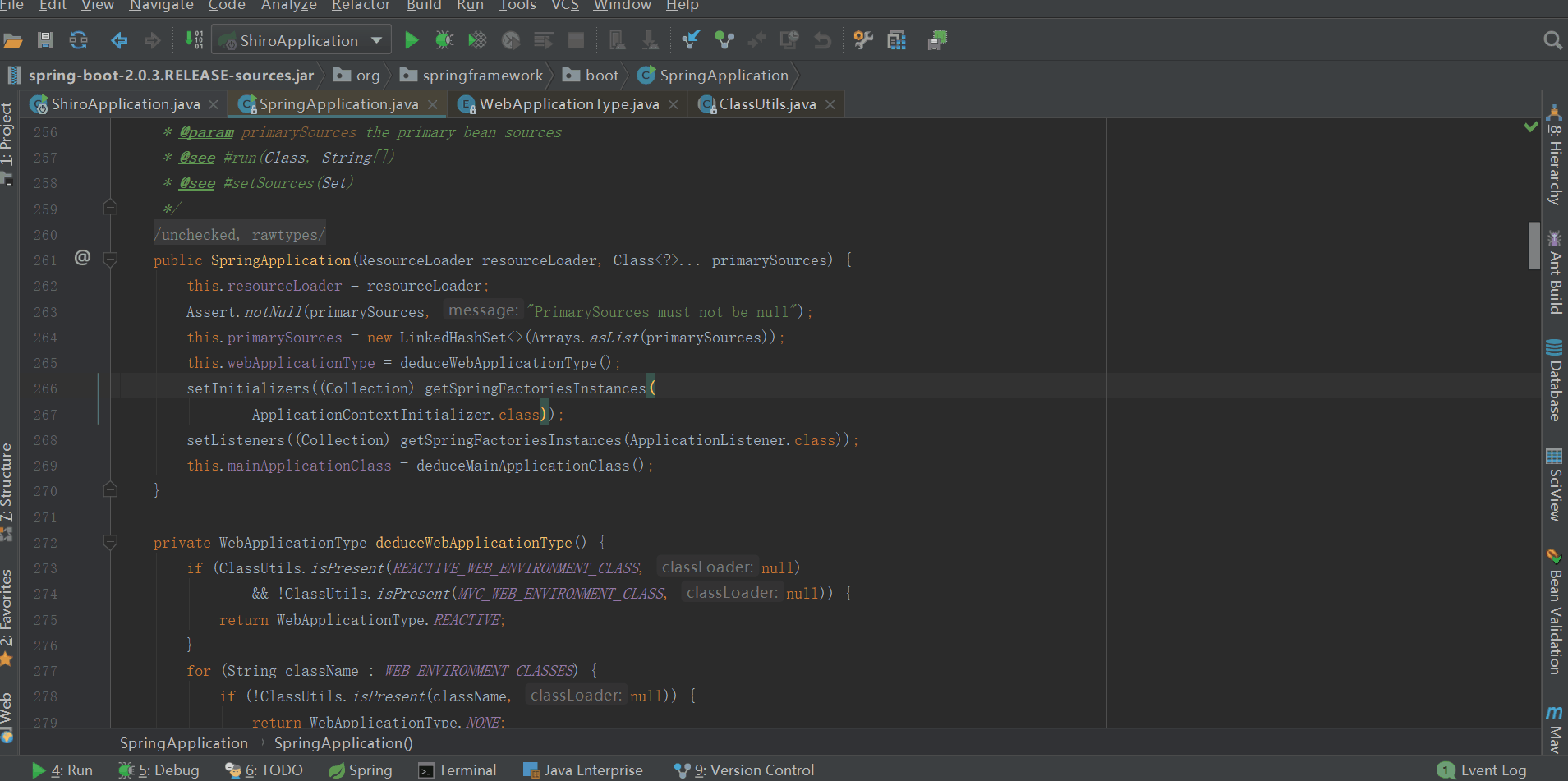
getSpringFactoriesInstances源码
private <T> Collection<T> getSpringFactoriesInstances(Class<T> type,
Class<?>[] parameterTypes, Object... args) {
ClassLoader classLoader = Thread.currentThread().getContextClassLoader();
// Use names and ensure unique to protect against duplicates
Set<String> names = new LinkedHashSet<>(
SpringFactoriesLoader.loadFactoryNames(type, classLoader)); // 获取指定类型的工厂名字
List<T> instances = createSpringFactoriesInstances(type, parameterTypes, // 根据名字、类型创建工厂实例
classLoader, args, names);
AnnotationAwareOrderComparator.sort(instances);
return instances;
}
从源码我们看出主要做了三件事:
1、loadFactoryNames,加载指定类型的工厂名称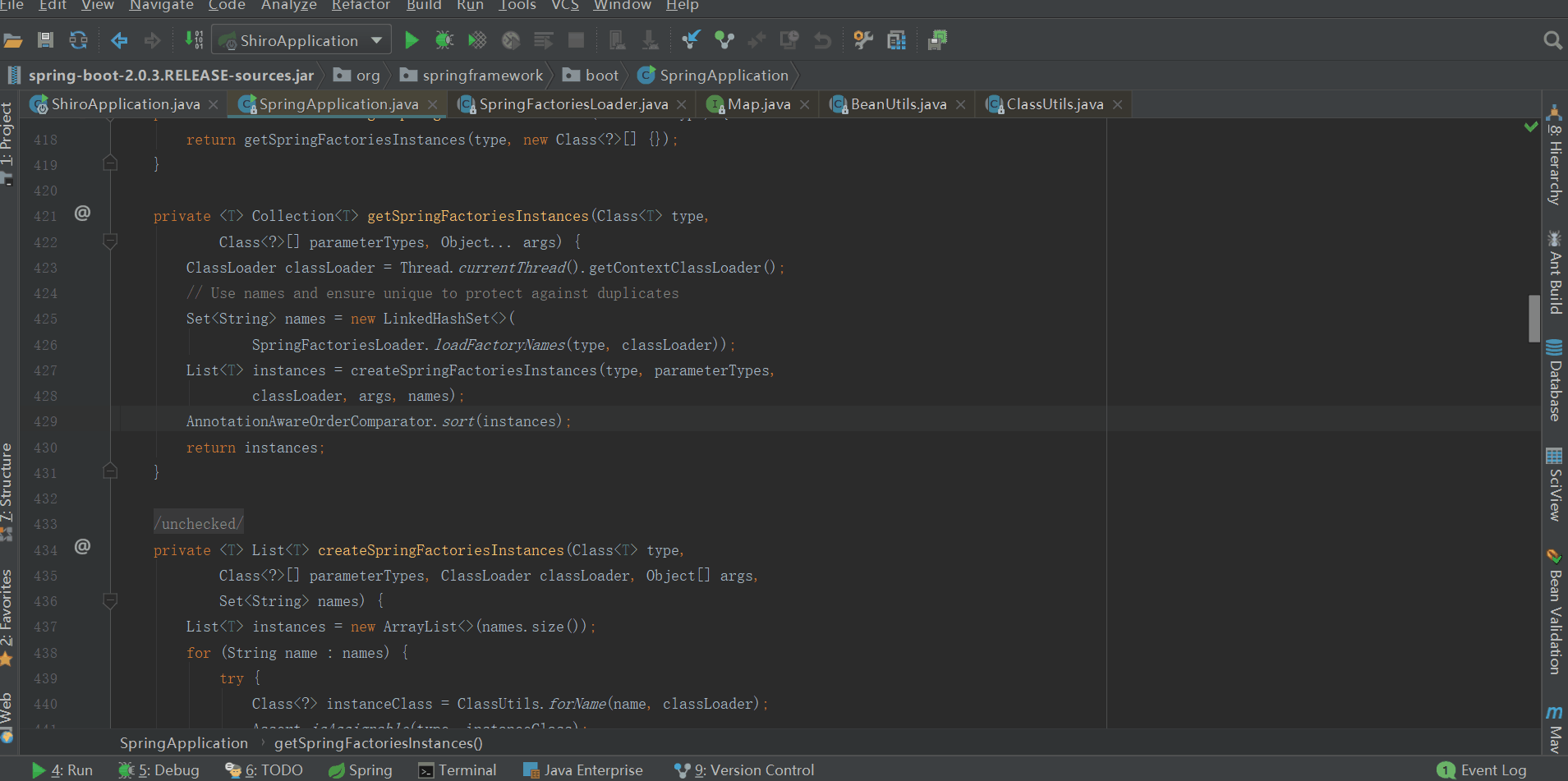
loadSpringFactories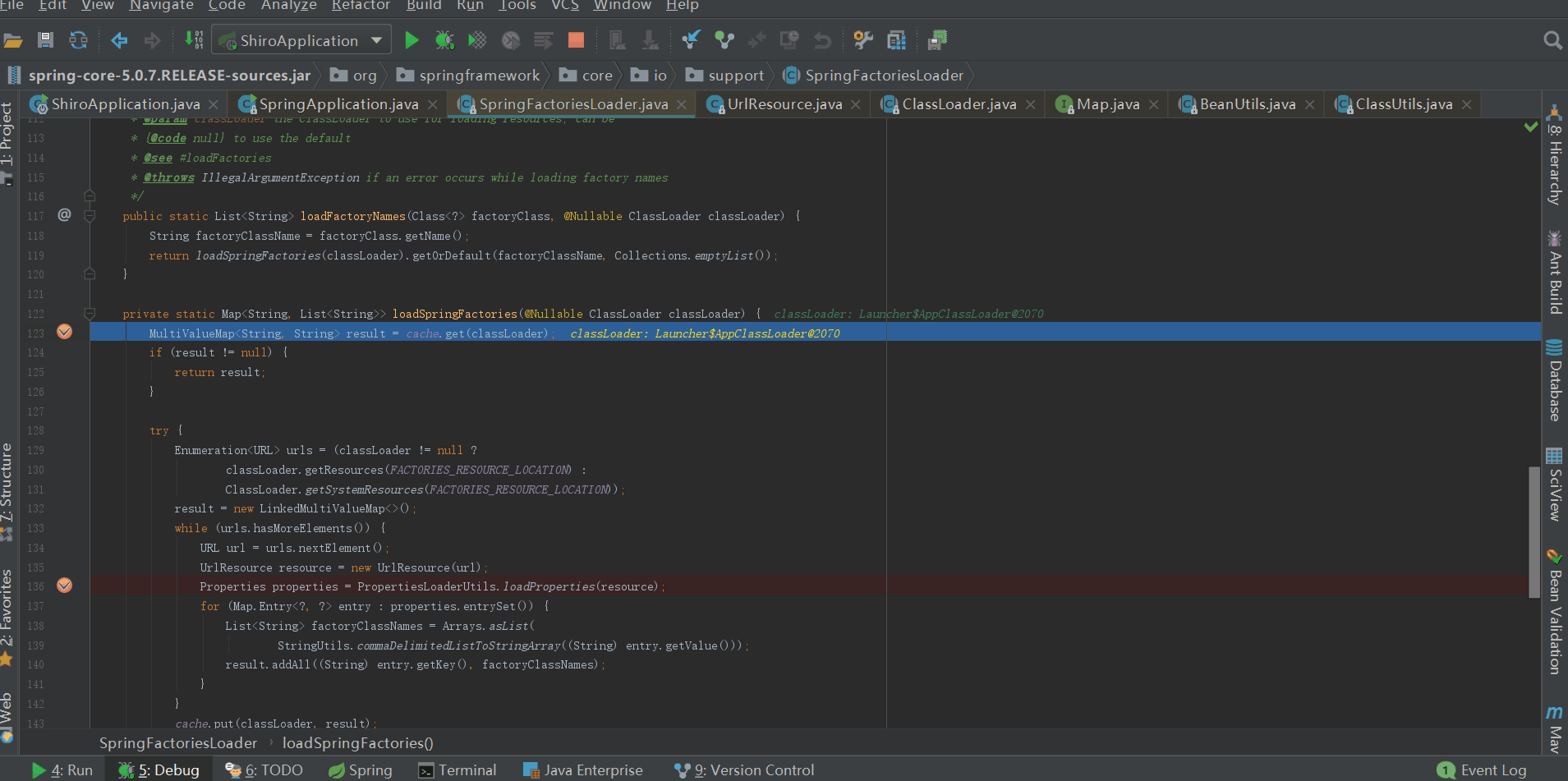
loadSpringFactories源码
private static Map<String, List<String>> loadSpringFactories(@Nullable ClassLoader classLoader) {
MultiValueMap<String, String> result = cache.get(classLoader);
if (result != null) {
return result;
}
try {
Enumeration<URL> urls = (classLoader != null ?
classLoader.getResources(FACTORIES_RESOURCE_LOCATION) :
ClassLoader.getSystemResources(FACTORIES_RESOURCE_LOCATION)); // classLoader.getResources(FACTORIES_RESOURCE_LOCATION)获取类路径下全部的META-INF/spring.factories的URL
result = new LinkedMultiValueMap<>();
while (urls.hasMoreElements()) { // 遍历全部的URL,逐个读取META-INF/spring.factories中的属性
URL url = urls.nextElement();
UrlResource resource = new UrlResource(url);
Properties properties = PropertiesLoaderUtils.loadProperties(resource);
for (Map.Entry<?, ?> entry : properties.entrySet()) {
List<String> factoryClassNames = Arrays.asList(
StringUtils.commaDelimitedListToStringArray((String) entry.getValue()));
result.addAll((String) entry.getKey(), factoryClassNames); // 属性全部放入MultiValueMap<String, String> result中,注意result的类型
}
}
cache.put(classLoader, result); // 结果放入缓存,方便下次查找
return result;
}
catch (IOException ex) {
throw new IllegalArgumentException("Unable to load factories from location [" +
FACTORIES_RESOURCE_LOCATION + "]", ex);
}
}
loadSpringFactories做了以下这些事
a、 查找类路径下全部的META-INF/spring.factories的URL
b、 根据url加载全部的spring.factories中的属性,spring.factories内容如下
c、 将所有spring.factories中的值缓存到SpringFactoriesLoader的cache中:
private static final Map<ClassLoader, MultiValueMap<String, String>> cache = new ConcurrentReferenceHashMap<>();方便下次调用。
加载完所有的工厂名称之后,然后从中获取指定工厂类型的工厂名称列表,也就是getOrDefault(factoryClassName, Collections.emptyList())做的事。
2、createSpringFactoriesInstances,创建指定类型的工厂实例
根据上面获取的指定类型的工厂名称列表来实例化工厂bean,我们可以简单的认为通过反射来实例化,但是具体的实现也没那么简单,感兴趣的小伙伴可以自己去跟。
3、对工厂实例进行排序,然后返回排序后的实例列表
排序规则:@Order从小到大排序,没有order则按没排序之前的顺序。
deduceMainApplicationClass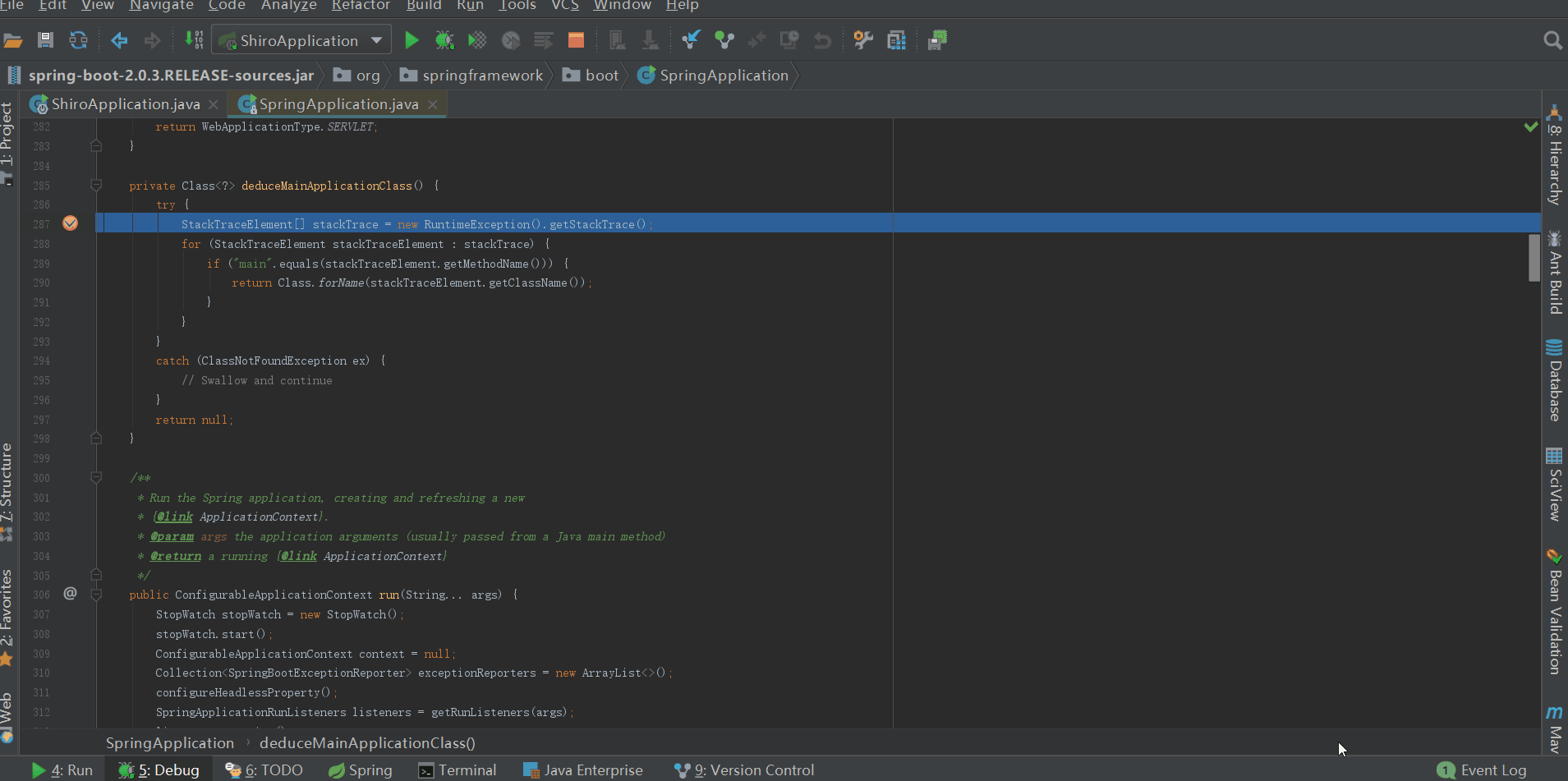
从当前堆栈跟踪列表中获取main方法所在的类名
构造方法总结
1、 构造自身实例
2、 推测web应用类型,并赋值到属性webApplicationType
3、 设置属性List<ApplicationContextInitializer<?>> initializers和List<ApplicationListener<?>> listeners
中途读取了类路径下所有META-INF/spring.factories的属性,并缓存到了SpringFactoriesLoader的cache缓存中
4、 推断主类,并赋值到属性mainApplicationClass
构造方法完成之后,实例的属性值如下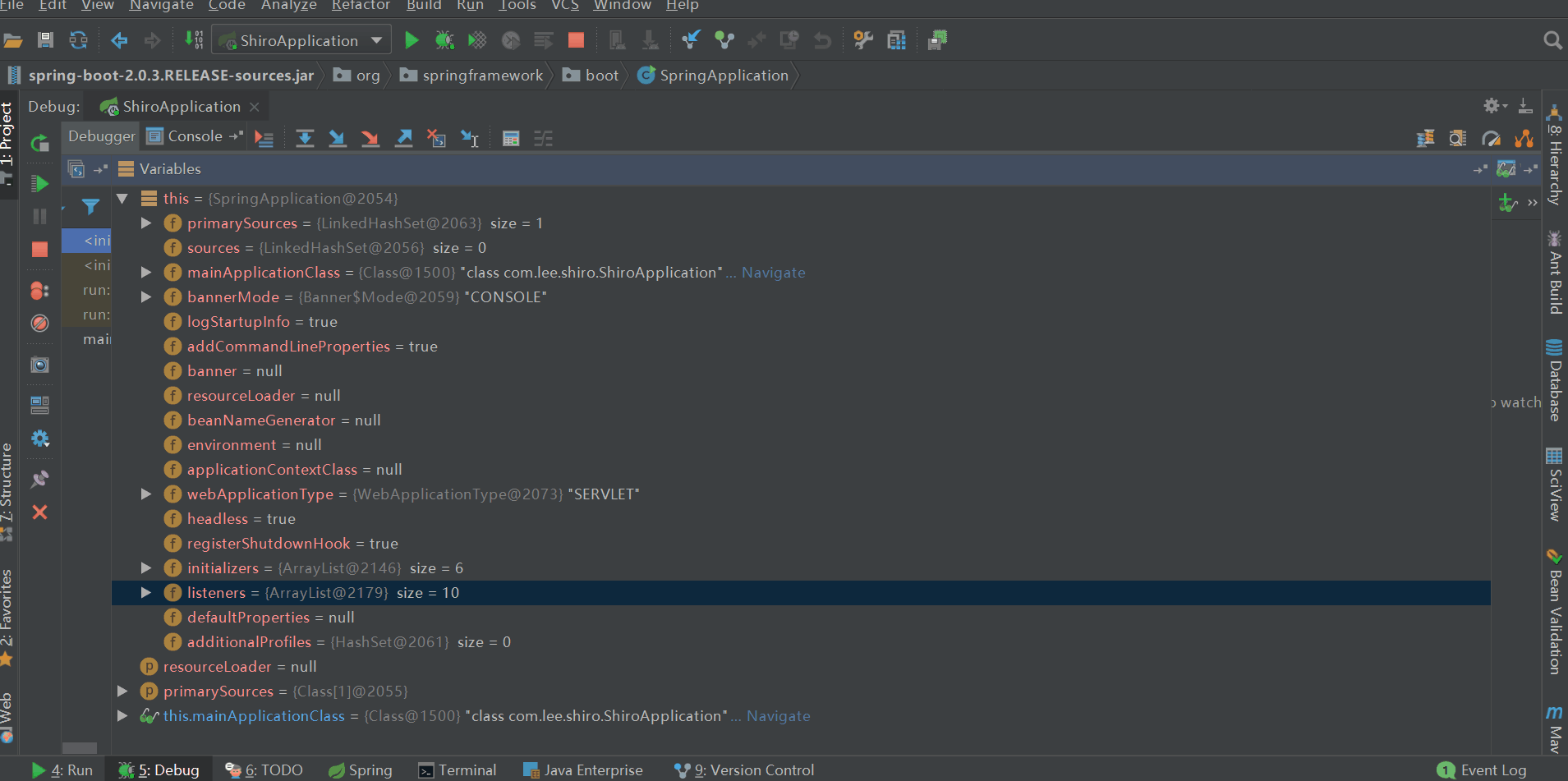
感想
本来是想着springboot启动源码解析只用两篇来说明的,之后讲shiro的源码;可我写着写着发现好多实例莫名奇妙的就被实例化了,很多细节没有读到,所以决定细抠,将springboot的启动过程拆分成多篇来讲解,真真正正的明白springboot在启动的过程都做了些什么。
补充一句:有时候,不是对手有多强大,只是我们不敢去尝试;勇敢踏出第一步,你会发现自己比想象中更优秀!诚如海因斯第一次跑进人类10s大关时所说:上帝啊,原来那扇门是虚掩着的!
参考
springboot源码
spring-boot-2.0.3启动源码篇一 - SpringApplication构造方法的更多相关文章
- spring-boot-2.0.3启动源码篇二 - run方法(一)之SpringApplicationRunListener
前言 Springboot启动源码系列还只写了一篇,已经过去一周,又到了每周一更的时间了(是不是很熟悉?),大家有没有很期待了?我会尽量保证启动源码系列每周一更,争取不让大家每周的期望落空.一周之中可 ...
- spring-boot-2.0.3启动源码篇 - 阶段总结
前言 开心一刻 朋友喜欢去按摩,第一次推门进来的是一个学生美眉,感觉还不错:后来经常去,有时是护士,有时是空姐,有时候是教师.昨天晚上推门进去的是一个女警察,长得贼好看,身材也很好,朋友嗷的一声就扑上 ...
- spring-boot-2.0.3启动源码篇三 - run方法(二)之prepareEnvironment
前言 此系列是针对springboot的启动,旨在于和大家一起来看看springboot启动的过程中到底做了一些什么事.如果大家对springboot的源码有所研究,可以挑些自己感兴趣或者对自己有帮助 ...
- spring-boot-2.0.3启动源码篇五 - run方法(四)之prepareContext
前言 此系列是针对springboot的启动,旨在于和大家一起来看看springboot启动的过程中到底做了一些什么事.如果大家对springboot的源码有所研究,可以挑些自己感兴趣或者对自己有帮助 ...
- spring-boot-2.0.3启动源码篇四 - run方法(三)之createApplicationContext
前言 此系列是针对springboot的启动,旨在于和大家一起来看看springboot启动的过程中到底做了一些什么事.如果大家对springboot的源码有所研究,可以挑些自己感兴趣或者对自己有帮助 ...
- Spring Boot REST(二)源码分析
Spring Boot REST(二)源码分析 Spring 系列目录(https://www.cnblogs.com/binarylei/p/10117436.html) SpringBoot RE ...
- SpringBoot 源码解析 (五)----- Spring Boot的核心能力 - 自动配置源码解析
在上一篇博客中分析了springBoot启动流程,大体的轮廓只是冰山一角.今天就来看一下springBoot的亮点功能:自动化装配功能. 先从@SpringBootApplication开始.在启动流 ...
- Spring Boot Dubbo 应用启停源码分析
作者:张乎兴 来源:Dubbo官方博客 背景介绍 Dubbo Spring Boot 工程致力于简化 Dubbo | grep tid | grep -v "daemon" tid ...
- Spring Boot 2.0 WebFlux 教程 (一) | 入门篇
目录 一.什么是 Spring WebFlux 二.WebFlux 的优势&提升性能? 三.WebFlux 应用场景 四.选 WebFlux 还是 Spring MVC? 五.异同点 六.简单 ...
随机推荐
- easyui属性赋值
了解easyui tree组件的童鞋估计都知道tree的node有他自己单独的属性(id,text,iconCls,checked,state,attribute,target).而原先这个几个属性想 ...
- Object constructor
1. Object is an instance of Function.2. Object does not have a property called constructor so when w ...
- EFLinq查询
1.无参数查询var model = db.Database.SqlQuery<UserInfo>("select* from UserInfoes ").ToList ...
- Chrome扩展插件流程
一.浏览器插件基础步骤: 1.文件最基础的配置 : 一个manifest文件.一个或多个html文件.可选的一个或多个javascript文件.可选的任何需要的其他文件,例如图片:在开发应用(扩展)时 ...
- CentOS 6下升级Python版本
CentOS6.8默认的python版本是2.6,而现在好多python组件开始只支持2.7以上的版本,比如说我今天遇到的pip install pysqlite,升级python版本是一个痛苦但又常 ...
- 论文word排版相关插件
其中包括破解版的MathType.EndNote X7以及Aurora 链接:http://pan.baidu.com/s/1boRZTmf 密码:a6ai
- shiro与项目集成开发
shiro与spring web项目开发 加入shiro的jar包 自定义realm /** * 自定义realm 继承授权realm * @author Administrator * */ pub ...
- package-lock.json,我们应该了解
原谅我占2017年12月31日一个坑,后续补上
- 【高速接口-RapidIO】6、Xilinx RapidIO核仿真与包时序分析
提示:本文的所有图片如果不清晰,请在浏览器的新建标签中打开或保存到本地打开 一.软件平台与硬件平台 软件平台: 操作系统:Windows 8.1 64-bit 开发套件:Vivado2015.4.2 ...
- JavaScript工作体系中不可或缺的函数
一.函数的概念 日常生活中,我们要完成一件事,总是习惯先有一个计划,后期按照计划,一步一步执行,则能够完成,并且达到一定效果实现一定的功能.在编程的世界里,“功能”可称呼为“函数”,因此“函数”即一段 ...
